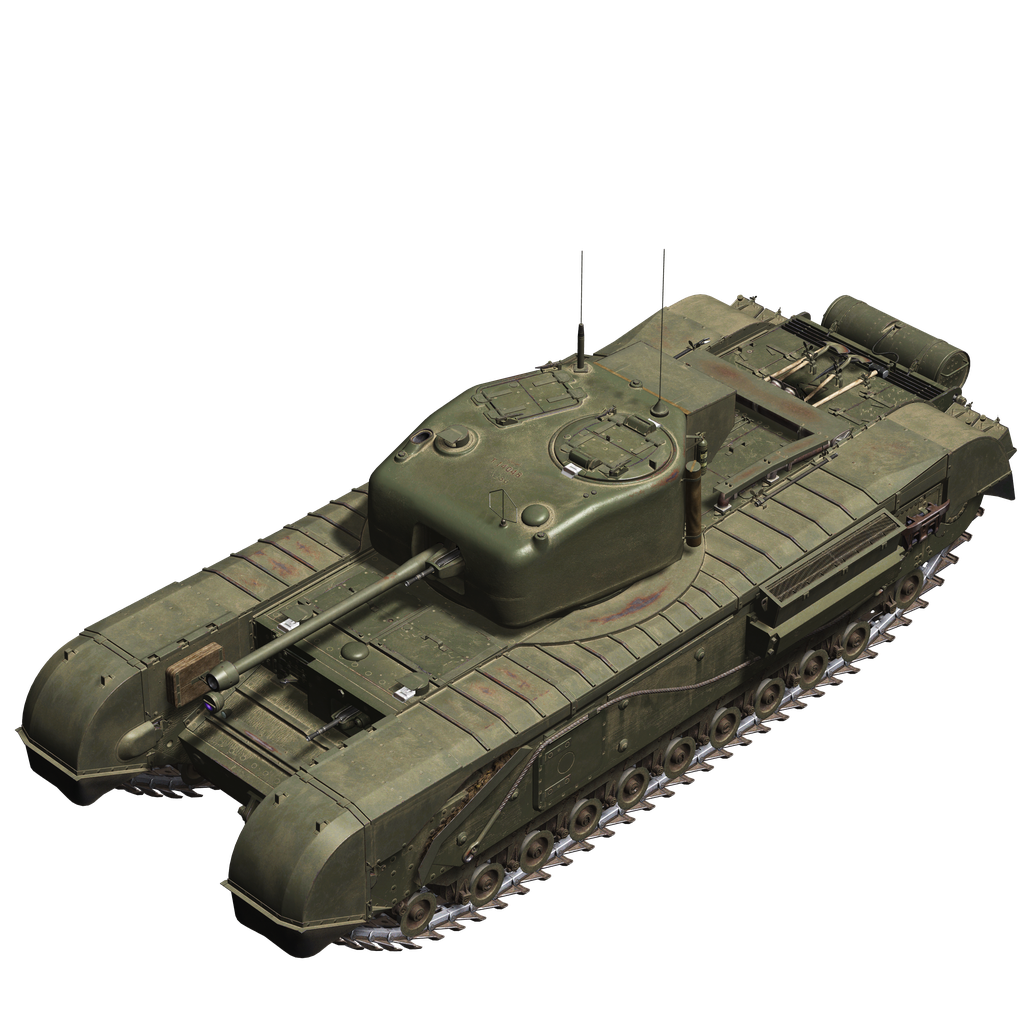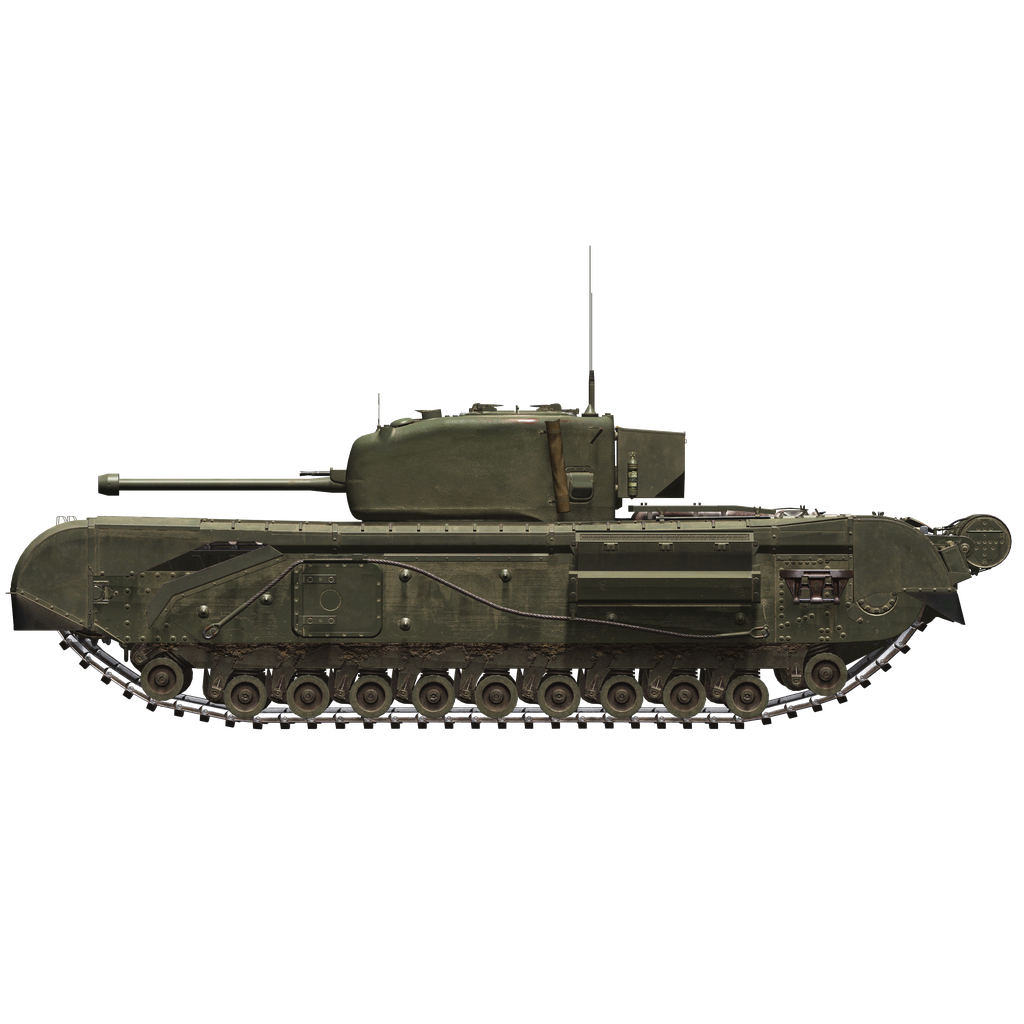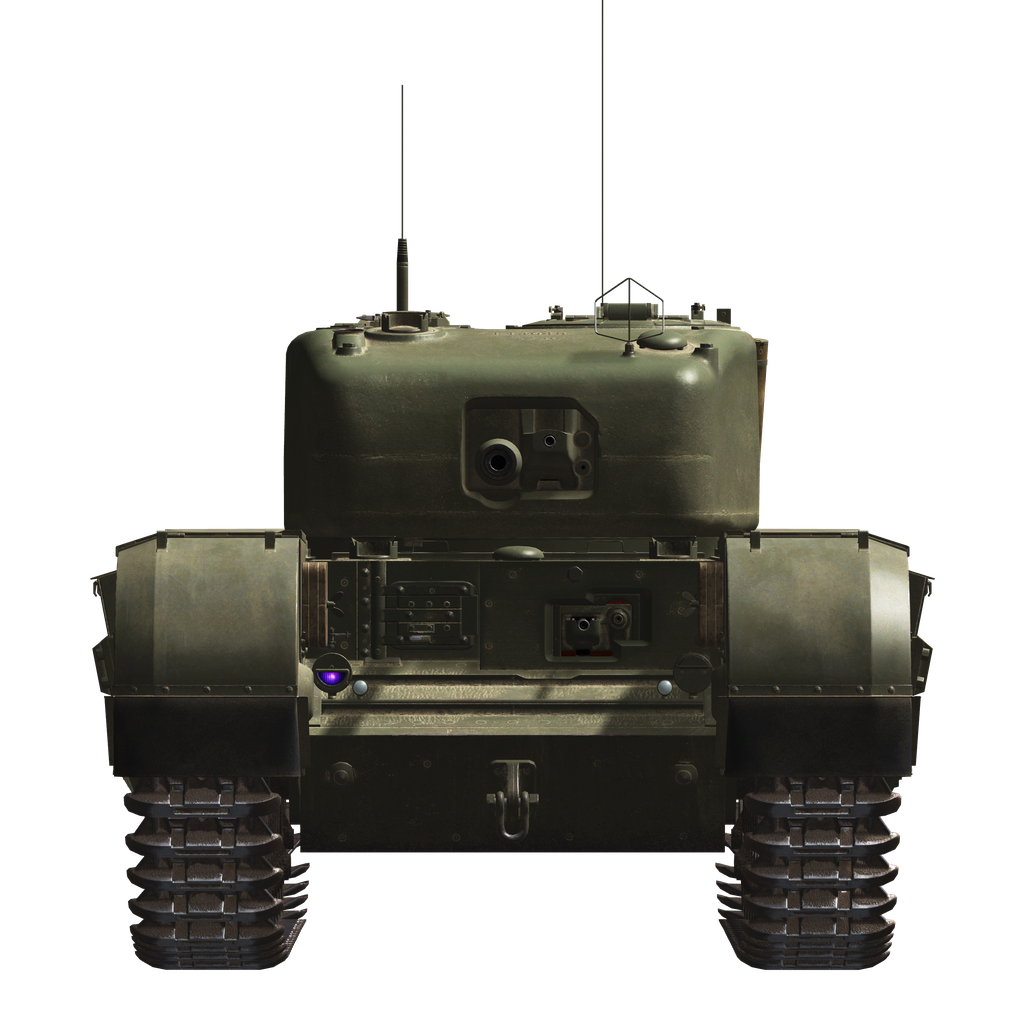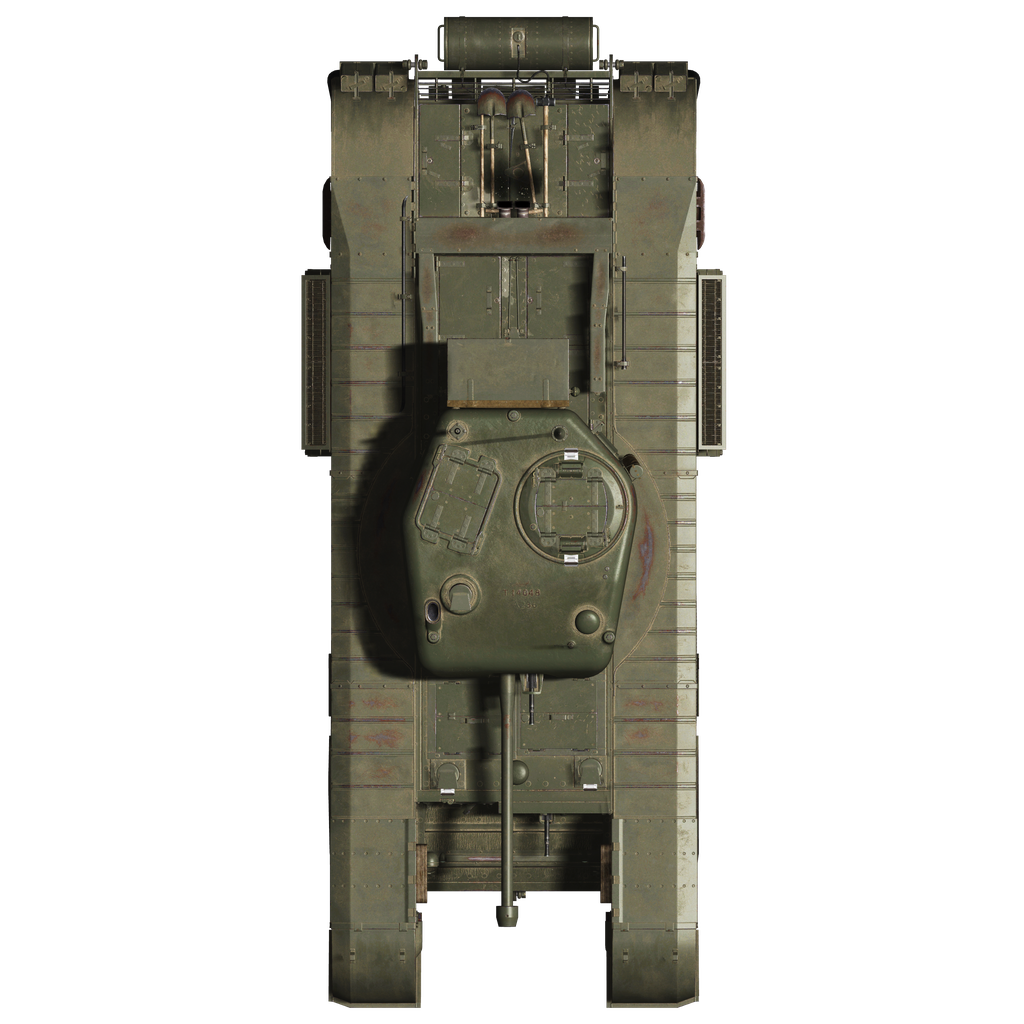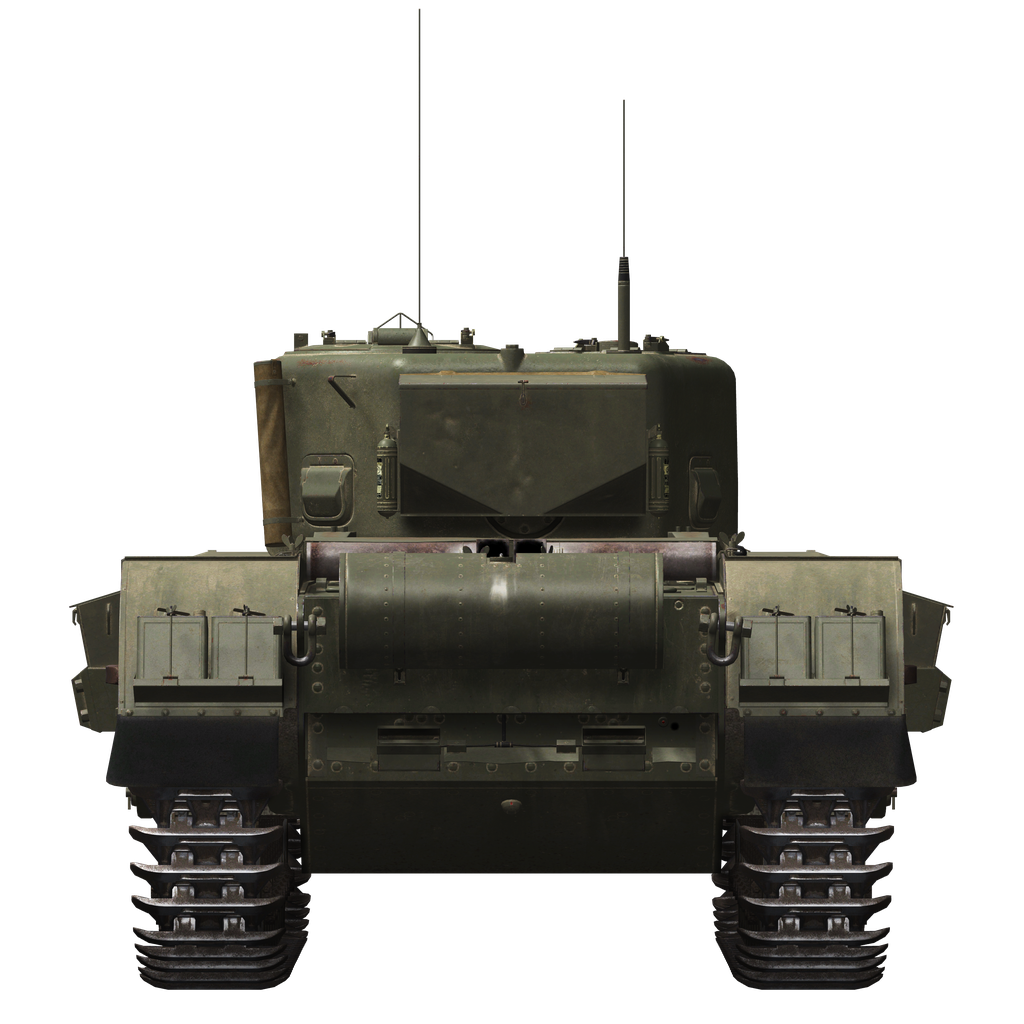The A22 Churchill infantry tank was designed in 1939-1940 as a successor to the Matilda infantry tank. Designed to accompany infantry in breaking through heavily fortified enemy defenses, the tank had powerful armor and became the heaviest tank of the Western Allies. Despite all the existing design flaws, the A22's good armor allowed it to be used quite effectively until the end of the war and even kept it in service until 1952.
The tank had a classic layout with the engine compartment in the rear, the fighting compartment in the middle and the control compartment in the front. One design feature of the tank was the tracks covering the top of the hull, just like the first tanks of World War I — but unlike them, all the road wheels had individual spring suspension. There were no support rollers; the upper branch of the track slid along special guides. This design made it possible to have additional escape hatches on the sides of the hull.
The tank's hull was made of rolled steel plates that were bolted and riveted to the frame. Unlike previous modifications, the Churchill IV had a cast turret.
The tank’s engine was a 12-cylinder carbureted water-cooled Bedford. Six gasoline fuel tanks were located in the engine compartment, while another one, which was removable, was located on the outside.
The armament of the A22C Churchill IV consisted of a "6-pounder" 57 mm MkV gun, which fired only solid armor-piercing shells. With a barrel length of 50 caliber, the gun gave a 5.85 kg projectile an initial velocity of 892 m/s: armor penetration was 60 mm at a distance of 950 m. A drawback of the weapon was the presence of only one type of armor-piercing projectile, which was not made with explosives; this reduced its after-armor effect. In addition to the cannon, the tank was armed with two 7.92 mm machine guns and a 51 mm breech-loading mortar for creating smoke screens — in the USSR, high-explosive fragmentation mines from a 50 mm company mortar were often used to fire mortars.
The crew of the tank consisted of 5 soldiers: the commander, gunner, and loader, who were in the turret, and the driver along with a machine gunner in the control compartment.
A total of 1,863 Churchill IV tanks were produced, 210 of which were later converted to the Churchill V modification.
The tank was delivered to the USSR under Lend-Lease. In the Red Army, Churchills, as well as Soviet-made heavy tanks, were supplied to separate Guards breakthrough tank regiments. Each regiment had 21 tanks and 214 men. They took part in the battles during the Battle of Kursk; for example, the 5th Guards Tank Army in the battles near Prokhorovka included the 15th (10 MK.IV tanks) and 36th (21 MK.IV tanks) Guards breakthrough regiments. On July 13, 1943, the 34th Separate Guards Breakthrough Tank Regiment arrived at the Bryansk Front, and on August 5, 1943, its Churchills were the first to break into Oryol. The 10th Separate Guards Breakthrough Tank Regiment was assigned to the 1st Guards Tank Army in mid-July, but already on July 21, during the battle, the regiment's tanks were cut off from the infantry, and 16 Churchills were quickly knocked out, after which the regiment was withdrawn to the rear and rearmed with other vehicles.
Churchill IVs also took part in battles in other sectors of the front: the 36th Breakthrough Tank Regiment was transferred to the Leningrad Front after Kursk. The 49th Separate Guards Breakthrough Tank Regiment, armed with 21 Churchill tanks and three Universal armored personnel carriers, also fought there.
In addition to the breakthrough regiments, these tanks were also used in small numbers by other units. A total of 344 tanks of modifications III and IV were sent to the USSR, but in the end, only 253 reached the front: the rest were lost during transportation by sea in Arctic convoys.
The USSR noted that in addition to good armor, the penetrating ability of the gun, a reliable radio station, and convenient observation devices, the tank had relatively low reliability, insufficient mobility, and low weapon efficiency due to the lack of high-explosive fragmentation shells in the ammunition load.
Used sources:
M. Baryatinsky “Armored vehicles of Great Britain 1939-1945” Armor collection No. 04 (7) 1996
M. Baryatinsky “Lend-Lease tanks in battle” 2009
B. Perrett. Churchill Infantry Tank 1941-51. 2002
The Churchill tank belonged to the class of infantry tanks developed by the British Army. According to this classification, the Churchill had low mobility and hardly the most powerful weaponry, but it was protected with powerful armor, and thus belonged to the class of heavy tanks. The tank was produced in England throughout the war years and was one of the most numerous armored vehicles in His Majesty’s armed forces. The model featured in the game was produced by the Leyland factory.
The first batch of early modification Churchill tanks under the Lend-Lease program was delivered to the USSR by the infamous Arctic convoy PQ-17. In total, 301 Churchill tanks were sent to the USSR during the war years, of which a little less than 50 vehicles were lost during transportation and 253 tanks were delivered to the Red Army during 1942 and 1943. The Churchill was the only heavy tank model supplied to the USSR by the Allies.
Churchills took part in the battles on the southern face of the Kursk Bulge in the summer of 1943. There, as part of the 2nd Guards Tatsinsky Tank Corps, they fought against the German Totenkopf and Das Reich Panzer Divisions. Alongside, on the same section of the frontline, Churchills served with the 5th Guards Stalingrad Tank Corps and the 18th and 2nd Tank Corps. Each of these Corps included 21 Churchill tanks, a total of 84 tanks - a third of the total number of tanks of this type supplied under Lend-Lease during the War.
The assessments of the tank in the Red Army were contradictory. Along with good armor, the cannon’s penetrating efficiency, a reliable radio station, and convenient observation devices, there were many problems with reliability, insufficient mobility, and the absence of high-explosive fragmentation shells in the ammunition load.
The main armament of the tank was the Ordnance Quick-Firing (QF) 6-pounder 7 cwt cannon. Two versions of this gun were installed on the tank: Mk.III with a 43-caliber long barrel and Mk.V with a 50-caliber long barrel (the game features the Mk.V variant). The only type of cannon shell featured a fairly high armor penetration. However, it was solid, i.e. did not feature a bursting charge, and this significantly reduced its after-penetration effect. Also, the lack of high-explosive fragmentation shells in the ammunition load was limiting its versatility.
From a technical point of view, the Churchill’s track assembly was quite peculiar and somewhat reminiscent of the famous British diamond-shaped pioneer tanks of the First World War, with the tracks covering the hull from above. This made it possible to include additional hatches along the sides that made it easier to abandon the vehicle in an emergency. Each of the 11 road wheels on either side of the tank had an individual spring suspension. However, only 6 middle ones of 11 were under load in the normal position. The hull armor was complex, comprising many rolled-steel armor parts assembled on the frame with rivets and bolts. The key feature of the Churchill IV, which distinguishes it from the previous modifications, was the turret made of a single cast part with a thin-walled spare parts box attached to its rear. The gun mantlet featured an original “internal” design with no parts protruding from the turret.
The tank was also equipped with a 2-inch mortar fixed on the roof of the turret, on the loader’s side. Normally, it was intended for remote smoke screen deployment with 2-inch smoke grenades fired at a distance of about 140 meters in the direction same as that of the tank gun. In the reality of the Eastern Front, the Red Army often used Soviet-produced 50-mm high-explosive fragmentation rounds as ammunition for 2-inch English mortars. The firing range for such a mine was about 410 meters. Besides the mortar, the tank was equipped with two pyrotechnic smoke dischargers mounted on the rear. They allow the tank to deploy a smoke screen for a minute and a half.
Unladen weight: 40500 kg.
Length: 7.6 m.
Width: 3.3 m.
Height: 2.5 m.
Clearance: 484 mm.
Engine: Twin 12-cylinder Bedford "Twin-Six", petrol.
Maximum power: 350 HP at 2200 RPM.
Maximum RPM: 2550 RPM.
4 speed gearbox.
Maximum road speed:
1-st: 2.0 mph (3.3 kph).
2-nd: 5.7 mph (9.1 kph).
3-rd: 10.9 mph (17.5 kph).
4-th: 18.2 mph (29.3 kph).
Reverse: 1.1 mph (1.7 kph).
Maximum offroad speed: 11 mph (18 kph).
Fluids:
Internal fuel tanks capacity: 682 l.
Engine oil system capacity: 25 l.
Summer engine coolant: 100 l. of water
Winter engine coolant: 100 l. of 43% alcohol 15% glycerol
Endurance range: 210 km.
Maximum oil consumption: 1.3 l/h.
Hull armor:
Upper front: 92 mm rolled armor.
Lower front: 83 mm rolled armor.
Sides: 70 mm rolled armor.
Rear: 51 mm rolled armor.
Frontal roof: 19 mm rolled armor.
Rear roof: 16 mm rolled armor.
Frontal bottom: 19 mm rolled armor.
Rear bottom: 16 mm rolled armor.
Turret armor:
Front bulges: 89 mm cast armor.
Front center: 114 mm cast armor.
Sides: 76 mm cast armor.
Rear: 76 mm cast armor.
Roof: 35 mm cast armor.
Cupola: 19 mm cast armor.
Gun mantlet: 89 mm cast armor.
Main gun: rifled, 57 mm 6-pounder 7 cwt MkV.
Barrel length: 50.
Elevation: +20°..-11°.
Ammo: up to 81 rounds.
Usable rate of fire: 12 rounds per minute.
Turret drive: electric, 26 seconds per rotation.
Ammunition:
6pdr APT armor piercing solid (AP): 2.8 kg, 890 m/s, 104 mm at 500 m.
Coaxial and bow MGs: 7.92 mm BESA.
Bullet mass: 11.5 g.
Muzzle velocity: 823 m/s.
Armour pentration at 100 m: 10 mm.
Rate of fire: 850 rounds per minute.
Coaxial: 20 belts, 225 rounds per belt (4500 rounds).
Bow: +-17°/+16°..-8°, 15 belts, 225 rounds per belt (3375 rounds).
Gunsights:
No.39 Mk IV gunner telescopic sight, field of view 13°.
No.39 Mk IIs machinegunner telescopic sight, field of view 21°.
Radio equipment:
Wireless Set No. 19. HF/VHF transceiver.
5 intercom terminals.
